by Chris Ritter
A question I am often asked these days is what I think the Commission on a Way Forward is going to propose. I don’t have any insider information. I do have several friends from across the spectrum that are Commission members, but they uniformly stick to referencing the official statements of their blue ribbon group. The Commission actually “belongs” to the Council of Bishops and our episcopal leaders will get the first peek. Since the bishops don’t convene again until November, we can expect something of a lull until then.
But, of course, that won’t keep us from speculating.
A press release came out yesterday from the Commission that some have argued doesn’t say much. I disagree. I think it says quite a lot. According to yesterday’s status update, the future they will propose will look very different from the one we have now. They see a “loosely configured structure” with a “thinner Book of Discipline.” In other words, they are bringing a massive structural plan that will fundamentally alter our understanding of United Methodism.
I see this as a positive. It means we are not going to get some sort of weak sauce local option. It also means that the voice of the global church is being taken seriously. The fact that the evangelicals and Africans on the Commission are heading down this road means that it will not be some sort of single “U.S. Central Conference” Plan that allows standards for the American church to lurch leftward in some sort of wholesale fashion. I interpret the Commission’s words to mean that there will be more than one flavor of United Methodism in the United States. (Those who have been paying attention know this is already the case.) Since this is a peace plan, we will have more than one team for annual conferences to join, along with some sort of sorting mechanism that will put dissident congregations and clergy in a new group should they wish this. Peace can’t be achieved any other way.
I know a few things about structural proposals for the UMC, having written several myself. One thing all large structural plans share is that they impact our Constitution. Amendments to our constitution must be passed by a 2/3 margin at General Conference and ratified in each of the annual conferences across the globe by the same aggregate percentage. This means United Methodists will be holding their collective breaths not once but twice. One will be at General Conference 2019 in St. Louis when the plan is voted on. (If it fails by five votes, what is the back-up plan?) The other pregnant pause will last at least a year as annual conferences across the globe vote to ratify. If we push the timetable, we might know by General Conference 2020 whether the grand plan is acceptable to the church.
Based on yesterday’s press release, the Commission will be offering us nothing short of a “New Connectionalism.” The United Methodist Church will become an umbrella for several smaller denominations, each with their own ministry standards.
WARNING: What follows is wholesale speculation on my part. It is not based on any insider information. This is just me extrapolating based on what I know of the landscape and the players around the table in the Commission.
REDEFINING UNITED METHODISM
The nature of the UMC would transform into a much looser umbrella organization providing connection and shared services to its affiliated denominations. It would be more communion than church. Each annual conference in the United States would be organized out of their current jurisdictions and into one of three overlapping “central conferences.” (Central conferences are what we currently call the seven regional clusters of annual conferences we have around the world. They are analogous to our U.S. jurisdictions.) I think the Commission will probably find a new name for these upper judicatory structures, but for now I will use the name we currently have. Think “little denomination.” Everyone would be United Methodist, but in another sense no one would be United Methodist. Each of the ten denominations will have its own name, ministry rules, and Book of Discipline that stands underneath a thin general Discipline.
Why would America be divided into three central conferences? Why not two? I believe the Moderates on the Commission would insist on a middle option from which U.S. annual conference could choose. Rather than being organized solely on geography, the U.S. central conferences would be based on ministry covenants and would overlap on the map. One judicatory would keep the current ministry standards in the Book of Discipline (and mean it). For our purposes here, I will call it the Traditionalist Central Conference and I depict it on the maps below in blue. A second judicatory would be silent about whether LGBTQI persons should be married and ordained so that these matters could be handled at the local church and conference level. The assumption would be that this central conference would slowly transition to full LGBTQI acceptance. I will call this the Centrist Central Conference and depict it in green. A third judicatory would immediately guarantee the right of LGBTQI persons to have same sex marriages in church and for conferences to ordain clergy regardless of their sexual practice. I will call this the Progressive Central Conference and depict it in yellow.
The U.S. Central Conferences would function much like our current jurisdictions, but with more responsibilities. They would elect and fund their own bishops. Instead of being superintendents of the whole church, bishops would be superintendents of their central conference. I assume here that international central conferences would likewise see an expansion of their responsibilities. Perhaps the central conferences would determine how long bishops serve, what their level of authority would be, and how clergy are deployed. The UMC Council of Bishops would become a forum for conversation instead of directional leadership. The college of bishops in each central conference would superintend the conferences under their care under the authority of their central conference Discipline.
ENACTING THE GRAND PLAN
Once this plan is approved, a vote would be taken in each U.S. conference for affiliation in one of these three new U.S. Central Conferences (denominations). Those local churches and clergy who could not live with the decision of their annual conference would be granted permission to affiliate with the U.S. central conference of their choosing. That central conference would place dissident congregations in one of their own annual conferences through their remapping process. Financial arrangements would be made so that congregations exiting their home conference would take with them a fair share of any unfunded pension liabilities.
DRAWING A NEW MAP
I am a visual person. Info-graphics, charts, and maps graphs really help me understand things. For this reason, I wanted to develop annual conference maps based on three overlapping U.S. Central Conferences. Of course, this is an impossible task as it requires clairvoyance into how each conference would vote a couple years from now.
The Progressive Central Conference would, on its surface, seem like the conference of choice for the eleven annual conferences that have officially voted to defy the UMC ministry standards. However, progressivism is an inherently missionary ideology. Why would our most progressive conferences vote themselves into an ideological ghetto when they have the opportunity to advance their cause into new territory? For this reason, I think there stands a good chance that the Progressive Central Conference would be left empty. But the model I developed nevertheless shows these eleven annual conferences in yellow and as part of their own central conference.
The Moderate Central Conference will be fairly attractive to many United Methodists because it is simply the one in the middle. We tend to like the middle of the road. The question remains, however: Will the middle still be the middle once the Traditionalists are gone? While there is some legitimate doubt that Progressives would choose the Progressive Central Conference, there is no doubt that many Traditionalists would be leaving to their own judicatory. This exit will have a leftward slingshot effect on those trying to hold the middle.
Take a look at the Schism Map I recently developed. You can see where the most stridently Progressive areas of the UMC are (shown in white and light gray).
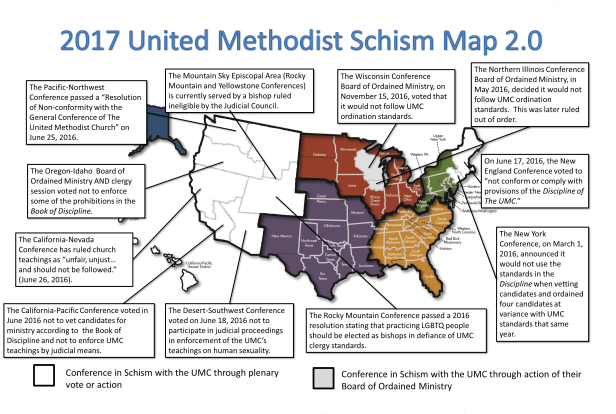
Now, compare this with what we know about America. We can almost predict the shape of the future three American United Methodist denominations. Their conferences will be geographically larger in those areas where fewer of their ideology reside.
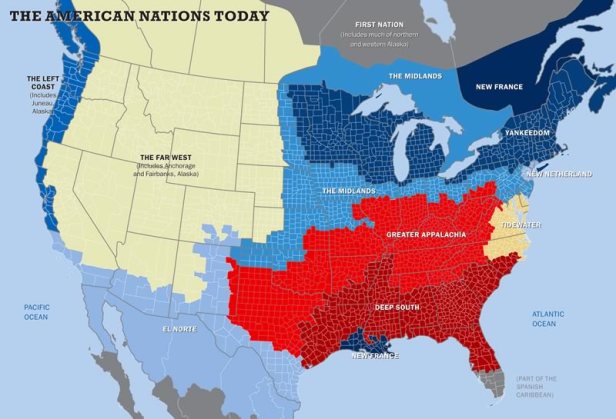
GENERAL ASSUMPTIONS
Every model begins with assumptions. Here are mine:
- Conferences in the new paradigm will be built on the foundation of existing UMC conferences. Annual conferences are the basic unit of the church with membership, assets, and liabilities. They exist as a legal unit whereas the United Methodist Church technically does not. (The UMC is a collection of conferences and general agencies with no formal legal incorporation). Almost all annual conferences in this model would have their roots in an existing conference. That being said, there would be nothing to prevent a U.S. central conference from organizing a brand new conference to cover some of its geography.
- Almost all annual conferences will become geographically larger. It stands to reason that dividing the U.S. into three overlapping judicatories will means that conferences (if they retain something close to their current membership size) will generally be covering more territory. This will be more pronounced in the most divided parts of our nation and less pronounced in homogeneous conferences.
- When voting to join a central conference, U.S. annual conferences would not just be choosing a stance on homosexuality, but they would be selecting the group of Methodists they wish to conference with in the future, including in the election of bishops. Abortion, divestment from Israel, and other social issues would also get folded into the discussion along, with apportionment rates, clergy standards, educational requirements, and other dynamics.
- I assume the eleven conferences that have already broken with the UMC would go into the Progressive Central Conference (shown in yellow). There is a possibility that more would join them, but it should be noted that conferences will be trying to find an option that will keep as many of their congregations in the fold as possible. This means that progressive-leaning conferences will often choose green over yellow. In fact (as stated before) there is a high likelihood that no conference would select the most progressive conferences option.
- Another factor keeping the Progressive Central Conference small will be its lack of strong representation in the South where most United Methodists live. As conferences and congregations vote, they will want to avoid geographic isolation.
- The middle option will be very attractive to many in the U.S., except for that the fact that this group will likely slingshot to the left with the exodus of the traditionalists. The middle conference will, by definition, be in flux for the foreseeable future. Traditionalist congregations and clergy of the Centrist Central Conference could gradually be targeted or otherwise pressured to change their position.
- Most churches and clergy will stay with their existing conference through inertia. Conservatives motivated enough to make a change will likely change to the Traditionalist Central Conference. (Those conservatives leaving a Progressive conference would not go to a Centrist conference but to a Traditionalist conference. Those leaving Traditionalists conferences, however, will likely join a Centrist conference over the most Progressive one.)
- The Traditionalist (Blue) Central Conference will have a legitimate claim to centrism in that they can argue that they are keeping the current UMC ministry standards.
STATISTICAL ASSUMPTIONS
Here are the statistical assumptions on which my model is built:
- All conferences will lose at least some churches to another U.S. central conferences and gain other congregations as their borders are widened in the inevitable remapping process.
- The exodus will be felt most acutely in those geographic areas that are most ideologically divided. A conference like West Ohio will feel much more practical change than the California-Pacific or Mississippi Conference, for instance.
- The rate of “leakage” is difficult to guess. But here is my attempt:
- Progressive conferences will only lose churches to the traditionalist central conference, and at an average rate of about 10%. If a church is motivated to leave, they will not just join the Centrist (green) Central Conference, but go all the way.
- Traditionalist conferences will tend to only lose churches to the Centrist central conference, and at a rate of about 10%. Churches in conservative areas will likely not make two jumps to the left and face geographic isolation.
- Centrist conferences will only lose churches to the Traditionalist central conference, and at a rate of 25% on average. There will be little motivation for Progressives to leave a Centrist conference because they will have the permissive ministry standards they have been seeking. The conservatives, however, will leave these moderate conferences in more significant numbers.
Here is where my model resorts to particularly large speculation. What conferences will go where? For the sake of a beginning point, I assigned the eleven conferences currently in schism to the Progressive Central Conference. I then chose a slightly higher number of conferences to go with the Traditionalist Central Conference (shown in blue). I chose six conferences at random in the South Central Jurisdiction and ten at random from the Southeastern Jurisdiction. Argue with these assumptions all you want. This is just a thought exercise.
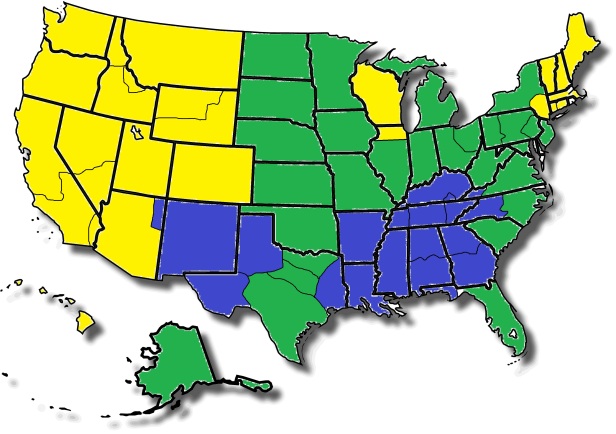
Annual conferences vary greatly in size from jurisdiction to jurisdiction. Excluding missionary conferences, I calculated the average annual conference membership size in each jurisdiction. I then extrapolated (using the statistical model above) how many members in each jurisdiction would fall in the Progressive, Centrist, and Traditionalist Central Conferences.
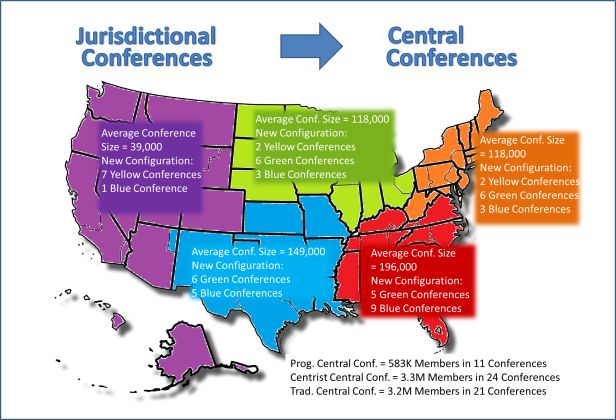
The more detail I give you, of course, the shakier my information becomes. I went ahead and randomly mapped the three new United Methodist denominations based on their projected representation in each of the old jurisdictions.
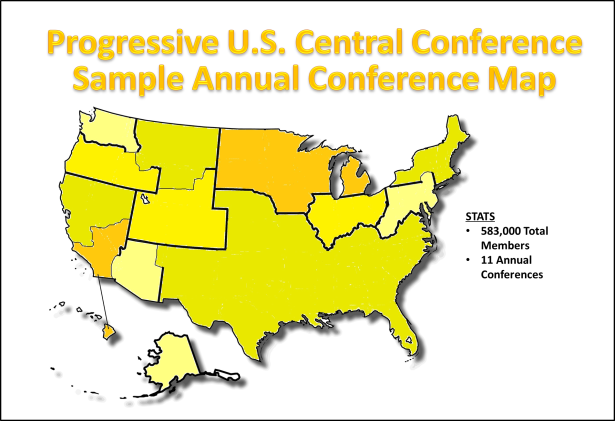
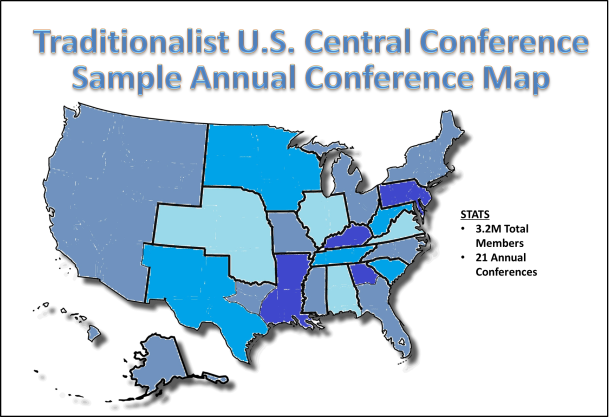
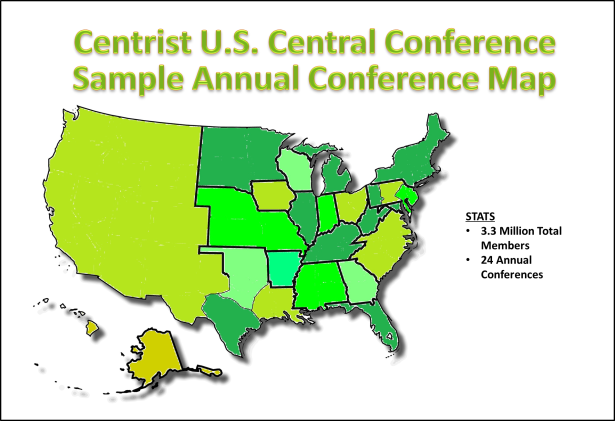
Using the average conference size, I was able to calculate how many members would be in each new Central Conference in each of the old jurisdictional territories. Using this VERY rough model:
- The Progressive U.S. Central Conference would have eleven conferences and 583,000 Members.
- The Centrist U.S. Central Conference would have 24 Conferences and 3.3 Million Members.
- The Traditionalist U.S. Central Conference would have 21 Conferences and 3.2 Million Members.
As the maps show, the Progressive Central Conference would be strongest in the West, Northern Midwest, and Northeast. If this Central Conference had a presence in the South, it would be as an extremely large and sparsely populated missionary conference. The Traditionalist Central Conference would be strongest in the South with some representation in the Northern Midwest and Northeast. Its western conference would be geographically very large unless it adapted a new, smaller conference model.
ANALYSIS
Those who followed the development of my Jurisdictional Solutions will recognize the similarities. Just as I am no longer promoting them, I am not necessarily supporting this model, either. I simply think that something like this is the only place The Commission can go given their mandate and the current environment. Of course, their particular model will be diverge from mine in any number of ways.
The final nail in the coffin of the Jurisdictional Solution was, I think, the election of Karen Oliveto as a United Methodist bishop. When you need separate episcopacies, you need a separate church. And this is really what this plan involves: The formation of three new Methodist denominations under the umbrella of American United Methodism. A necessary allowance for the acceptance of this model would be the dissolution of the general superintendency of bishops. A bishop in one Central Conference would not have official temporal and spiritual oversight in any of the others. United Methodism globally will become a confederation of smaller denominations similar to the World Methodist Council.
I expect the American central conferences would not call themselves “Progressive”, “Centrist” and “Traditionalist.” They would choose separate denominational names and logos. What would these three denominations share? Along with the seven central conferences that currently exist, they would be part of ten global denominations that comprise a new form of United Methodism. They would share a long history. They would be served by and help shape the reorganized General Boards and Agencies of the United Methodist Communion. There would still be a Council of Bishops, but the role of this group would be reduced as more energy is placed at the College of Bishops level.
There are technically eight books of discipline that currently serve the UMC: One General Discipline and seven subsidiary central conference Disciplines. The customizations currently allowed in the Central Conference Disciplines are extremely limited and do not extend to ministry standards or Social Principles. This would need to change under the new paradigm. Central Conference Disciplines (like the one found here) would become more powerful, unique, and their number would grow to ten. As the Commission has hinted, the global Book of Discipline would be rather thin. This means the powers of General Conference would be significantly reduced. Judicial bodies would be needed at the Central Conference level to interpret the various Disciplines.
HOLDING OUR BREATH
If the Commission brings a grand plan like this to General Conference 2019 and it fails the required supermajority passage, there will be a very long and uncomfortable “Now what?” moment. We could be in for a scramble to find some way to hold our United Methodist flotilla together. If the plan passes, the church will have a year-long uncomfortable wait as the ratification votes take place. Will African conferences vote favorably upon a plan that allows some United Methodists to take an alternative view to human sexuality? Time will tell. If ratification fails, it would be up to General Conference 2020 to make a last ditch effort to avoid dissolution of the connection.
All these factors are very good reasons to redouble our efforts in praying for The Commission. It looks to me like they are working to put forth a very bold comprehensive plan.
Note: David W. Scott offers a very helpful contribution related to how the Central Conferences might fare in a loosened UM Connection. Check it out at UM & Global. This post serves as a good primer on global United Methodism and balances the U.S.-Centered analysis that I offer.

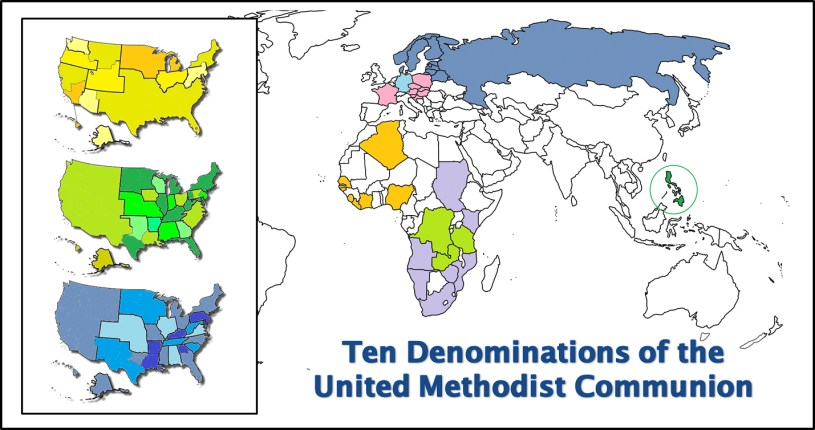
I understand this is conjecture but it is well supported. My concern with this path: What does this do about the General Boards. I have no interest in maintaing the burdens of unresponsive agencies such as GBCS, GBHEM, or GBGM as they are currently constituted. A greater problem than LGBT issues for the Next Methodism is the maintenance of costly institutions which not only refuse to support the mission of the church but which actively work against it.
Thanks for reading! This is an open question, for sure. I would argue that our general agencies are awkwardly configured as is. For instance, our General Board of Pensions (Wespath) only serves the U.S. church, but they are “general” agency beholden to our global General Conference. There are other examples. I think we may have to take all this a step at a time. Central Conferences could decided what they want to pay into. I think the GBCS would perhaps be the most obsolete in this configuration.
Wespath embarked a few years ago on central conference pastoral pension support with Liberia being a trial conference. I am aware that there was a funding campaign with modestly successful results and which raised pension funding for central conference pastors, beyond Liberia. So the statement that Wespath only serves the U.S. church is not entirely accurate.
Thank you, Randy. I appreciate your deep knowledge of the church.
Thank you for all your work. Do you think it is likely the plan would provide each congregation the ability to opt out of the United Methodist Church altogether and be independent, while taking an appropriate share of liabilities?
In Christ,
The enemy hates clarity
Thanks Chris for this. I think if this forecast is accurate, traditionalists that choose the centrist option will find themselves appreciated and respected in this new world. I don’t think the energy will be channeled to try to convert churches and clergy who hold the traditional view, on the contrary they will be invited to offer leadership in a new centrist branch for the sake of diversity of thought. I think the passionate debate will turn to the question of fiscal and structural reform in a Centrist branch. The next conflict in a Centrist expression of church will be between institutionalists and local church clergy and laity who long for the local church to be center of our concern as opposed to the current state of affairs where the local church feels sidelined by pursuits that are often disconnected from the local church. In the end, I think one the greatest attraction points to any new central conference will be the cost associated with each option.
I think this is about as good an outcome as could be hoped for. I’m not sure where I would fall in this configuration between the centrist and progressive options. In my current ministry context, I have a large percentage of LGBTQ students, but aside from my support for LGBTQ inclusion, my theology tends to be too evangelical for the Marcus Borg wing of the church. It may be that God sends me with the progressives in order to preach a more traditional Wesleyan gospel in that space. I just want there to be some way out of this impasse. I have always appreciated your thoughtfulness regarding possible solutions for moving forward. I am not optimistic about anything that requires 2/3 ratification from gatherings where the median age is 70.
Perhaps 13 United Methodisms. :O
http://www.umc.org/news-and-media/africans-look-at-changing-the-churchs-map
Reading the description it looks like the non DRC portions of the Congo Central Conference would be placed with two of the four succeeding conferences from the Africa Central Conference.
I’ll send a visual to you more directly.
I would love to see it. Thanks!
All of this makes my head hurt, but I made it through your article. Thank you. You have provided this reader at least a possible outline for the future that Bp Carter’s mumbo jumbo does not provide. The only good news for me is that the General Boards of Global Ministries and Church and Society at a very minimum least should not survive. In my wildest fantasies the Methodist Building in DC is sold to Donald Trump Jr. to be developed into a luxury hotel with penthouses for the Trumpkins.
Chris: thoughtful and thought provoking. Help me understand. Where do the hospitals (and schools below university) in Africa get funded? I would have speculated GBGM. Yes? I am concerned that hospitals (and schools?) in Africa will lose if we are not careful and intentional in their funding continuance. Your concern on GBGM mirrors mine on a few others. Again, thoughtful and thought provoking. Thank you.
I assume that the general agencies like GBGM would remain in place and that the Commission would keep them at something approximating their current level of funding. However, massive change would be on the horizon once the U.S. sorting happens and these new bodies start to dialog about what they want to fund, and not. Thanks so much for reading and offerings your comments.
Understood as a thought exercise and a good article. Seems like a typical UMC approach–overly complicated and flying over the heads of the average member. If this is the solution my response will be to simply leave altogether. While I am not ready to leave yet I am getting the suitcase out of the closet.
I hear you, John. Thanks for taking a look. I think most United Methodists will be guided by the health of their local church rather than the goings on at the denominational level. It will be fascinating to watch for the direction The Commission leads us.
Thank you , Chris, for this thought exercise. It is very well conceived. You mainly dealt with Central Conferences, Jurisdictional Conferences, Annual Conferences and Local Conferences (Churches). What about clergy? How would we sort ourselves out? And once we decide which Conference we wish to belong to would there be limitations to where we could serve? I can think of a dozen other questions concerning clergy in your “thought exercise”. Any thoughts about this?
Thanks for checking out this post, Gary. All clergy would have the option of staying in their existing conference. In many cases, geographic borders will be widened, so we would be itinerating within a larger territory. Some clergy, however, will feel the need to realign with one of the other Central Conferences. This does not mean that their appointment would immediately change, however. We have clergy serving across annual conference lines all the time and I think this would be even more true during the sorting period. There are well-established processes for clergy to move from one conference to another. Some clergy would move along with their congregations, I would think. Because the global BOD is going to be “much thinner”, I think things like guaranteed appointments, clergy standards, and even the means of clergy deployment will be a matter for each Central Conference to decide. I have noticed that United Methodism in general is one big clergy union. We get half the votes in our conferences and we seldom make decisions that are bad for us. I would be interested in hearing your further thoughts, as well.
I found a point I agree with (there are many, BTW) when I saw your sentence a few paragraphs down…”Everyone would be United Methodist, but in another sense no one would be United Methodist.” A plan/map/division like the one you have mapped out, kinda takes the “U” outta “United Methodist”….which, I concur with you, is probably going to happen…sadly for the folks who really want the “U” to survive this mess. Calling it “United Methodist” in any form is going to be a sham, and we shouldn’t include the “U-word” in the moniker at that point. The doctrinal issue (and the differences in views that exist) around gay ordination and gay weddings would make that heresy, and outright dishonest to call us “united” in any sense of the word, would it not?
Someone once said that any organization with “United” in the name… isn’t. Thanks for reading and commenting.
We could very easily change the name of the denomination to “Untied.”
You wrote, “there is no doubt that many Traditionalists would be leaving to their own judicatory.”
Respectfully, I don’t think this is true at all. Traditionalists won’t be leaving to their own judicatory, they will simply be leaving given that this is ultimately a compromise of Biblical principles, or, put another way, a loss.
By that, I mean that this plan is essentially a convoluted version of the “local option” plans we’ve heard before (Traditionalists will maintain the current language of the Discipline while Progressives will change it. Which, by the way, leaves no room for so-called Centrists, because on the divisive issue-at-hand–homosexuality–everyone will have to choose one approach over the other.)
Orthodox, evangelical, conservatives (aka, Traditionalists) simply will not agree to this plan because it effectively surrenders and declares that the high view of Scripture and the Biblical standards of morality/sexuality/marriage that have been lived into, defended, and fought for over the last five decades no longer matter.
The analogy that comes to mind is that of a troubled marriage in which one spouse is unfaithful to the other.
After counseling, they agree to put their understanding of marriage and their vows aside and allow the unfaithful spouse to continue in their infidelity, while other one continues in their faithfulness.
This, of course, is a wholesale rejection of the historic definition of marriage, a rejection of the original vows they made, and in fact, a complete redefinition of marriage.
As such, one spouse gets everything they want, while the other is forced to live with it.
I fail to see how this plan does anything other than that.
But I am confident that if this truly is the plan, it will be rejected out of hand by the Traditionalists.
Forgive a second money related question on this mind experiment. Is it your assumption that the three central conferences in the USA would continue to pay for the (now no longer general) superintendcy in the other seven Central Conferences (status quo?).
Thanks for the question. If the plan was to make it through the Council of Bishops (the body that will actually bring a proposal to GC2019), I believe there would need to be a provision for Central Conference bishops to receive salary support from some general church agency. While the Episcopal Fund would need to change, I think it would still need to exist.
100% agree that salary support for some would be necessary. Mindful this is a reflection in possibilities. I would still like to believe in stead of 10 denominations coming out, still one denomination (The Methodist Church?) with multiple strands. I see the possibility of three central conferences as worthy of a lot of reflection. As with my other concern on hospitals and schools, the UMC is doing a lot of international good. I hate to see that lost. I am 100% sympathetic that elements of the current infrastructure needs significant reevaluation. Significant.
Chris – for me, this was a helpful mind mapping exercise. Thank you for your work here.
The values being compromised under any compromise plan are God’s values. The majority does not want that. I believe the General Conference will not approve a compromise. Then they can look toward restoring God’s Values and the Methodist way of life that brings people closer to God. It includes accountability for things such as a life of debauchery. In Matthew the theme of Jesus ministry is repentance. Some, but not all are willing to turn from their sins and live a New Life.
Once you have compromised on an important point like morality, you are no different from the world. To follow Christ, you have to be different.
This won’t really matter, but in looking at all the maps and conjecture and speculation I just had to respond: You know, what continues to amaze me is how we, as both an overall belief system of Jesus followers, (I hesitate to use the word Christian) and as a denomination of United Methodists, presume to speak for God. What arrogance we have! Where is God in any of this mess? Where are our Methodist roots – Do no harm, Do good, Stay in love with God? Or even better, “United Methodists respect the diversity of opinions held by conscientious persons of faith. Wesley followed a time-tested approach: “In essentials, unity; in non-essentials, liberty; and in all things, charity.” (http://www.umc.org/what-we-believe/section-2-our-doctrinal-history). Where is the liberty? Where is our charity? I was taught, love the Lord your God with all your heart, soul, mind and strength, and your neighbor as yourself. “On these two commandments hang all the law and the prophets.” (Mt.22:40 NRSV). Nowhere within these ideals does it say only select people that we, and people who think like us, believe are OK. God calls who God calls. God neither wants, nor needs our advice or approval on who God chooses to call. But no, we have become the Sanhedrin – believing we have the authority, even the heavy burden of responsibility, to make decisions for the “good” of the people instead of focusing on and acknowledging the love and grace of God. The UMC has become all about bureaucracy and about economics. It’s about guaranteed appointments, pensions, and whether someone is — in the eyes of the Discipline and/or the Board of Ordained Ministry — worthy to be ordained a UM Pastor. It’s crap. Maybe if we went back to preaching in fields rather than in our hallowed sanctuaries we’d get back in touch with what it means to be God’s people.
Thanks for reading and commenting, Kate. There is a very deep divide in our church that runs much deeper than discussions about what constitutes Christian marriage. It really goes to the sources of authority for the Christian life. I get that all the maps and conjecture are a little much, but this is the conversation our church will be having for the next couple years at least. I agree that street preaching is an essential practice of our faith that we need to return to.
Actually it’s not that the maps are overwhelming or a little much, they are very straightforward, though a little short sighted; it is the conversation that has failed to advance over the course of the last several years that has become at best an annoyance and at worst the cancer that is slowly killing the denomination, and it could even be argued that it’s not that slow.
To say that we will be having this discussion ignores that we have already been having this discussion for many years already. We can call the argument “Christian Marriage” now in 2017 but that doesn’t change the real argument – the stance of the church on homosexuality. The United Methodist Church failed to come to a consensus on this issue at the 2008 general conference, and then again at the 2012 general conference. Finally, it was decided in 2016 that a “Way Forward” was needed. So only then was a committee formed, whose purpose is only to prepare for a discussion in 2019. And now, what we see in your article is yet another example, even in conjecture, of the church through committee, pushing the discussion down the road again.
You contend that all conferences will be able to exist under this unifying umbrella of the UMC and that everyone will get what they want. However the state of the church currently would argue that point. Already churches on both sides of the discussion are making preparations to abandon the general conference. Two churches in Mississippi have even started the process of separation already. The issues being raised over Bishop Oliveto would also argue this, as it was decided by the committee that she was not to be allowed to be a Bishop and her central conference ignored this.
This is the result of our failure as a church body to come together and take a stand. But unfortunately, the reality is that the church doesn’t want to take a stand because it’s bad for business. Should a decision be made it would alienate a portion of the consumers of the Methodist Church. This alienation would lead to a decrease in giving putting large amounts of strain on an already overburdened pension system that is about to break under the weight of the baby boomer preachers retirement. There is then the issue of land and building ownership that would need to be dealt with. Should a decision be made that a church doesn’t agree with they may want to take their property and bolt, but they can’t due to the design of the Methodist Church. The coming reality would be that they would either have to sell the properties on the cheap to the current church members or hold on to a burdensome property that drains the already stretched resources even further. The Methodist business would fail, and make no mistake this discussion revolves around the Methodist business.
This may be a cynical view, but it is reality. We as Methodists have moved away from what made us great. We have gotten caught up in the business of church, and if there is one thing Wesley had little time for it was the business of church. We wouldn’t find John Wesley in one of our great Methodist sanctuaries where these arguments are taking place. We wouldn’t find him hiding in the bureaucracy. We wouldn’t find him kicking something down the road. We would find him in the slums, the prisons, and on the streets preaching to those who need to hear. We would find him with the broken and sick. We would find him in the places the church refuses to go now. If we saw him in the pulpit he would be railing against us, challenging us to do more.
Once again, we are indebted to you, Chris, for an amazingly provacative “thought exercise,” stimulating reflection and conversation. In my heart of hearts, I hope you are entirely wrong about the nature and disposition of your proposed “Centrist Central Conference” becoming increasingly leftward leaning by those with far-left commitments and missionary zeal. There’s a reason why people choose the middle and I believe this group will be wise enough (and strong enough?) to resist those who attempt to move the middle to the left. Providing a place for the left to engage its ministry is a consoling thought; assigning a rather sinister motive to the left–that it should insinuate itself into the middle–is disconcerting–and this centrist would certainly resist!
Wow, Chris, that’s a tremendous amount of work. May I republish this on UM Insight? — Cynthia Astle
Thanks for your interest, Cynthia. I am OK with UM Insight re-posting this as long as the formatting stays true to the original… with the maps, etc. in their place with the text. Otherwise, I think it will get very confusing to read. As an alternative, you may also feel free to direct people to the original post. Blessings to you.
Thanks, Chris. I completely agree with your request, and have just finished formatting Insight’s presentation exactly as you describe. Also, I always link back to the original post so people can go there if they wish. I really appreciate your contribution!
I have a question. I have been serving in a Conference that has no unfunded liabilities. I was part of the campaigns to raise that. How will these changes affect that since so few Conferences have done this? I retire soon.
Thanks for the question, James. This model assumes that all the existing conferences will continue to exist and that churches who leave them would need to take with them a share of their conference’s unfunded liability.
I agree with the assessment that more than likely any attempt to “loosen the connection” is ultimately going to be nothing more than a local option that forces the decision down onto local churches that are already in trouble because they do not have any sort of adequate theological perspective to even have a rational discussion about what is the best move. I know they exist because I am a long time member of one! I predict that any attempt to “loosen the connection” is going to get a whole lot messier at the local level than anybody expects.
My plan from the pew: Live out the reality that almost 100 years ago Bishops decided that “doing” was more important than “believing” because hashing out what we believe would be “too divisive”. Therefore, let everybody do what they are already doing. and see who survives and who does not. Acknowledge that what is decided at General Conference has little or no impact on the local church so pare its function down to the bare minimum. I say this because I am extremely certain that any attempt to “loosen the connection” is going to decimate local churches and send annual conferences into chaos because at the local level things are not as cut and dried as the maps suggest. Local churches are ill prepared for if not totally clueless what is about to descend on them in the form of a “loosened connection”.
Thanks for reading. Your comments are always thoughtful. In the scenario I propose, churches that are “clueless” would probably follow the direction of their annual conference. For a church to choose its own group would presumably require a church conference. Hopefully there would be a model congregational study process developed or something. Thanks again.
Wesley would say the maps are not helpful because there are only two groups: People who have Jesus and people who need Jesus. Many people have been deceived into thinking they can live lives of debauchery, even sexual perversion and belong to Christ. They need a savior! Jesus calls us to repent and that means to turn around. You must turn your life around. Jesus even called this New Life being ‘Born Again.’ It’s living life a completely new way, like Nicodemous in the bible. He immediately stopped cheating people. Those not willing to do what the Master said are not following Him.
The majority of Methodists want to be true to God and not accept any compromise of God’s values on morality. When you live life as God planned, things go so much better!
As far as living a life of perversion, Rev. John Stott said it best. We need to be in harmony with God’s Plan of Created Order: “There can be no ‘liberation’ from God’s norms; True liberation is found only in accepting them.”
So don’t take your eyes off Jesus. Don’t even consider a compromise that allows immoral teachings in certain areas. Everyone needs the True Gospel. No one needs a false gospel! Once you have God’s Spirit, you will want to please God by living a moral life. Other lifestyles will even become repugnant. But first you must come to repentance and find Christ, our helper in time of need.
Thanks for reading and commenting, Skipper. Our current structure is allowing compromise, only in divisive and distracting ways. This is not a post about ideals but about what can be done given our current situation. I understand that these alternative organizational structures don’t get at the real, heart-level issues…. they can’t.
Interesting analysis. So currently, the local church is technically owned by the conference. Would there be organizations of new conferences who would have the assets of the church transferred to it? Or would these central conferences be more “virtual”?
I believe something like you suggest might be possible. Thanks for reading and commenting.
Chris
I enjoyed reading this explanation of where we are, and where we may be headed. I think that your speculative proposition about the possibility of ten different denominations- under one umbrella- may very well be our future as United Methodists. I want to offer a bit about my perspective and position. I’m not a cradle Methodist. I was raised in the Church of God (Cleveland, Tn.). I became a Christian at a very early age, felt a calling to ministry, attended and graduated from Lee University, and I became very confident in my own righteousness and abilities. This did not work out so well for me. I became a career soldier, deployed on several occasions, ended up divorcing, walking away from my faith. My heart was broken, and I ended up descending into some very sinful and rebellious years of angry hatred for God. I often think that I was headed toward becoming a reprobate; one with a seared conscience. Yet… the grace of God pursued me, called me, loved me, and changed me. Yet before this change and return to faith in Jesus Christ, I was a proud combat veteran; soldiering was my great strength, and I successful in my career.. but I was very far from God.
On Nov. 4th, 2005, tragedy struck my family. My dad, a very successful general contractor, and subdivision developer, committed suicide. On this very night, I realized that I couldn’t soldier up and carry this great pain. The lord used a UMC Army Chaplain, to reach out to me with the love of Jesus Christ. My re-awakening to the lord began that very night. With time, I felt a calling to ministry, eventually met the woman that would be a God send, and today I am happily remarried. I graduated from Memphis Theological Seminary, as well as United Theological Seminary. My faith is evangelical, Wesleyan, Renewalist, and yes, I am Centrist. Heterosexuality is normative, and from the statistics that I have read, I believe that over 95% of the population is heterosexual. Yet, I know several people that are gay; as in born gay, hard-wired gay, and their homosexual orientation is as innate to them, as my heterosexuality is to me… it’s who they are. Some of those very same people are celibate and single, some are promiscuous, and some are monogamous and partnered/married for life. Some of these married folks love and follow Jesus, live by and follow the scriptures, and are theologically orthodox. It is not the norm, but it is a reality. So, I think that there are many of us who are traditionalists, yet believe that there is grace for such persons. This position doesn’t satisfy the WCA, nor does it satisfy the RMN. So… I think that there will be a strong traditional-compatibilist group, and we will land in the centrist camp. We do not embrace promiscuity, and we acknowledge that the vast super-majority of the population is heterosexual. Yet, for that minority of people “born gay”, we believe that God may very well have grace for them, in much the same way as God does for the divorced and re-married. Our position is one of mercy and grace, kindness and compassion, as well as hope for the outcast. I have met enough people who are sympathetic to the WCA, yet they/we are open to this possibility, and with that, we will find ourselves in a centrist conference. Also, my ministry is multi-faceted, and I am very involved in some para-church evangelical ministries. I will be the first to say that the evangelical world is not all roses and candy canes. There are more than a few, that are harsh, judgmental, and even cruel. As a matter of fact, some of them would demonize WCA folks as liberal; you affirm women in ministry… For cradle Methodists this may not make sense, but I would offer a word of caution, for those who become the conservatives/traditionalists; you’ll have your hands full as well; conservative world can be very cruel.
So, my post is a bit of a personal narrative, but it’s important because it tells the story of how God used a grace filled, and Jesus loving Army Chaplain to reach a wayward Pentecostal guy, and lead him home to the Jesus that saves sinners, and gives them new life. And for many of us, we will find our home in the center. I am hopeful that this offers a perspective worth considering.
V/r
Jason D. Greene
Pastor, husband, dad, old soldier, and passionate follower of Jesus….
Great to hear your story, Jason. It will be fascinating to watch how the Uniting Methodist group navigates forward with the most stridently progressive elements in the UMC glomming onto them so enthusiastically. The center-right ground where you are seeking to stand will be very difficult to hold moving forward. I feel the two of us would have much in common in terms of ministry values. I agree that there should be grace for those who don’t fit neat categories. For instance, there are some polygamists that are otherwise very sincere disciples of Jesus. But the church must be very circumspect about what we encourage and bless. Sacrificing the New Testament definition of marriage in the name of inclusiveness would be selling the farm, in my humble opinion. Thanks for reading and commenting.